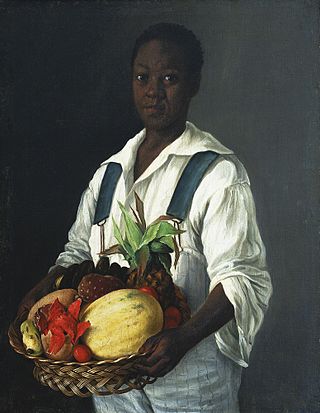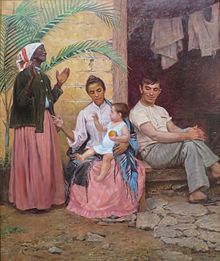
Mestizo is a person of mixed European and indigenous non-European ancestry in the former Spanish Empire. In certain regions such as Latin America, it may also refer to people who are culturally European even though their ancestors are indigenous. The term was used as an ethno-racial exonym for mixed-race castas that evolved during the Spanish Empire. It was a formal label for individuals in official documents, such as censuses, parish registers, Inquisition trials, and others. Priests and royal officials might have classified persons as mestizos, but individuals also used the term in self-identification.
White is a racialized classification of people generally used for those of mostly European ancestry. It is also a skin color specifier, although the definition can vary depending on context, nationality, ethnicity, point of view, appearance, etc.
Mulatto is a racial classification to refer to people of mixed African and European ancestry. Its use is considered outdated and offensive in several languages, including English and Dutch. But it does not have the same associations in languages such as Italian, Spanish and Portuguese. Among Latin Americans in the US, for instance, the term can be a source of pride. A mulatta is a female mulatto.
Afro–Latin Americans or Black Latin Americans are Latin Americans of full or mainly sub-Saharan African ancestry.

Mexicans are the citizens and nationals of the United Mexican States.

Casta is a term which means "lineage" in Spanish and Portuguese and has historically been used as a racial and social identifier. In the context of the Spanish Empire in the Americas, the term also refers to a now-discredited 20th-century theoretical framework which postulated that colonial society operated under a hierarchical race-based "caste system". From the outset, colonial Spanish America resulted in widespread intermarriage: unions of Spaniards, indigenous people, and Africans. Basic mixed-race categories that appeared in official colonial documentation were mestizo, generally offspring of a Spaniard and an Indigenous person; and mulatto, offspring of a Spaniard and an African. A plethora of terms were used for people with mixed Spanish, Indigenous, and African ancestry in 18th-century casta paintings, but they are not known to have been widely used officially or unofficially in the Spanish Empire.

Skin whitening, also known as skin lightening and skin bleaching, is the practice of using chemical substances in an attempt to lighten the skin or provide an even skin color by reducing the melanin concentration in the skin. Several chemicals have been shown to be effective in skin whitening, while some have proven to be toxic or have questionable safety profiles. This includes mercury compounds which may cause neurological problems and kidney problems.
Whitewash is a paint-like covering of hydrated lime or a cheap white paint.
White Latin Americans or European Latin Americans are Latin Americans of European descent.
Racial whitening, or "whitening" (branqueamento), is an ideology that was widely accepted in Brazil between 1889 and 1914, as the solution to the "Negro problem". Whitening in Brazil is a sociological term to explain the change in perception of one's race, from darker to lighter identifiers, as a person rises in the class structure of Brazil. Racial mixing in Brazilian society entailed that minority races ought to adopt the characteristics of the white race, with the goal of creating a singular Brazilian race that emulates the white race, striving to create a society best emulating that of Europe.
White Mexicans are individuals in Mexico who identify as white, often due to their physical appearance or their recognition of European ancestry. The Mexican government conducts ethnic censuses that allow individuals to identify as "White," but the specific results of these censuses are not made public. Instead, the government releases data on the percentage of "light-skinned Mexicans" in the country, which was 47% in 2010 and increased to 49% in 2017. The term "Light-skinned Mexican" is preferred by both the government and media to describe individuals in Mexico who possess European physical traits when discussing ethno-racial dynamics. However, "White Mexican" is still used at times.
Black Hispanic and Latino Americans, also called Afro-Hispanics, Afro-Latinos or Black Hispanics, or Black Latinos are classified by the United States Census Bureau, Office of Management and Budget, and other U.S. government agencies as Black people living in the United States with ancestry in Spain, Portugal or Latin America and/or who speak Spanish, and/or Portuguese as either their first language or second language.

Brazilian society is made up of a confluence of people of Indigenous, Portuguese, and African descent. Other major significant groups include Italians, Spaniards, Germans, Lebanese, and Japanese.
Racism in Cuba refers to racial discrimination in Cuba. In Cuba, dark skinned Afro-Cubans are the only group on the island referred to as black while lighter skinned, mixed race, Afro-Cuban mulattos are often not characterized as fully black or fully white. Race conceptions in Cuba are unique because of its long history of racial mixing and appeals to a "raceless" society. The Cuban census reports that 65% of the population is white while foreign figures report an estimate of the number of whites at anywhere from 40 to 45 percent. This is likely due to the self-identifying mulattos who are sometimes designated officially as white. A common myth in Cuba is that every Cuban has at least some African ancestry, influenced by historical mestizaje nationalism. Given the high number of immigrants from Europe in the 20th century, this is far from true. Several pivotal events have impacted race relations on the island. Using the historic race-blind nationalism first established around the time of independence, Cuba has navigated the abolition of slavery, the suppression of black clubs and political parties, the revolution and its aftermath, and the special period.
Racism in Mexico refers to the social phenomenon in which behaviors of discrimination, prejudice, and any form of antagonism are directed against people in that country due to their race, ethnicity, skin color, language, or physical complexion. It may also refer to the treatment and sense of superiority of one race over another.

There is no single system of races or ethnicities that covers all modern Latin America, and usage of labels may vary substantially.

Afro-Mexicans, also known as Black Mexicans, are Mexicans who have heritage from sub-Saharan Africa and identify as such. As a single population, Afro-Mexicans include individuals descended from both free and enslaved Africans who arrived to Mexico during the colonial era, as well as post-independence migrants. This population includes Afro-descended people from neighboring English, French, and Spanish-speaking countries of the Caribbean and Central America, descendants of enslaved Africans in Mexico and those from the Deep South during Slavery in the United States, and to a lesser extent recent migrants directly from Africa. Today, there are localized communities in Mexico with significant although not predominant African ancestry. These are mostly concentrated in specific communities, including the populations of the Oaxaca, Huetamo, Lázaro Cárdenas, Guerrero, and Veracruz states.
Racism has been present in Brazil since its colonial period and is pointed as one of the major and most widespread types of discrimination, if not the most, in the country by several anthropologists, sociologists, jurists, historians and others. The myth of a racial democracy, a term originally coined by Brazilian sociologist Gilberto Freyre in his 1933 work Casa-Grande & Senzala, is used by many people in the country to deny or downplay the existence and the broad extension of racism in Brazil.

In the former Portuguese and Spanish colonies in the Americas, pardos are triracial descendants of Southern Europeans, Indigenous Americans and West Africans.

Ham's Redemption, in Portuguese: A Redenção de Cam ; is an oil painting made by painter Modesto Brocos in 1895. Brocos completed the work while teaching at the National School of Fine Arts of Rio de Janeiro.










